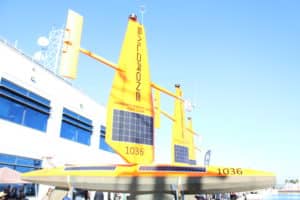Innovation District opens the Hub, unlocking ‘potential for extraordinary impact’

After nearly a year of negotiations with local officials, repurposing the city-owned SRI building and carefully curating tenants, the St. Petersburg Innovation District formally unveiled its waterfront Defense and Maritime Technology Hub Wednesday.
Succinctly called the Hub, Wednesday’s ribbon-cutting ceremony featured several prominent local and national dignitaries. Executives from some of the Hub’s 17 tenants – all with defense and marine science ties – introduced speakers representing the nearby National Oceanic and Atmospheric Administration (NOAA), the Department of Defense (DOD), Pinellas County and the City of St. Petersburg.

Pinellas County Commission Chair Charlie Justice (left center) and Mayor Ken Welch (right center) lead a large group of local and national officials in the ribbon-cutting.
As the first and largest tenant of the building, Ben Minichino, president of Pole Star Applications USA, was the first to address the crowd. Pole Star operates the National Data Center for the Coast Guard and Department of Homeland Security, taking complex geospatial data and turning it into actionable intelligence.
“We’re a small business, and for small businesses, the barriers to entry in the defense space are real, and they’re complicated,” said Minichino. “And what the city’s done for us today … is they’ve enabled innovation, and they’ve enabled and broken barriers to entry that honestly, we would have a lot of difficulty doing ourselves.”
Minichino said that before joining the Hub, he researched the cost to build a SCIF for his company. A SCIF is a secure room or data center that guards against electronic surveillance and a DOD requirement for sensitive communications. He said it was nearly a million-dollar investment for a small business to build one SCIF, and the HUB has seven or eight in operation.
“It’s an amazing partnership between private defense companies and the city and the Innovation District,” said Minichino. “I don’t know that there’s anything else like it in the world today.”
Mayor Ken Welch said the Hub brings together the triple helix of the innovation industry, government and academia under one roof. He also noted the building houses the Florida Flood Hub, which coordinates statewide efforts between academics and researchers to address the critical issues of flooding and sea-level rise.
Welch said tenants of the Hub are required to intentionally engage with the community and grow the future workforce of St. Petersburg. He explained that the building, measuring 38,000 square feet, features attributes not found anywhere else in the Tampa Bay region. These include waterfront access for drone and research vessel deployment and in-water testing and evaluation labs, in addition to the SCIFs.
The city expects tenants of the Hub to create nearly 120 new jobs with an average salary of at least $100,000 in the first two years of operation. Welch said that overall, he expects the 182 direct and indirect jobs created by the Hub to generate almost $15 million in new salaries.
“It’s clear that the Maritime Defense and Technology Hub is a dynamic innovation incubator for the city,” said Welch. “It will have a profound economic impact on the City of St. Petersburg for decades to come, and it will continue to spotlight St. Petersburg, Pinellas County and Tampa Bay as one of the top innovation destinations in the country.”

One of Saildrone’s autonomous uncrewed surface vessels outside of the Hub.
Dr. Rick Spinrad, Under Secretary of Commerce for NOAA, said he believes that the new, marine science-based blue economy, an overarching element of the Hub, is worth $100 billion. However, he said it would take an unprecedented level of partnership between the public and private sectors and academia to unlock that potential.
Spinrad said entities throughout the country claim they plan to start a hub or cluster of organizations supporting the blue economy and simply open up a warehouse to any business with a marine aspect. After just an hour at the Innovation District’s Hub, he claimed to have never witnessed such an incredible cohesion of concepts.
“The connective tissue, the cohesiveness and the potential for extraordinary impact are like nothing I have ever seen before,” said Spinrad. “I can’t say that strongly enough.”
Chris Miller, former acting secretary of defense and director of the National Counterterrorism Center, echoed Spinrad’s praise. He called Wednesday’s event a turning point in national defense and intelligence services history. He said Netflix would one day document the historical occasion, and called operations at the Hub “Tony Stark stuff” (a reference to the fictitious, brilliant scientist at the center of Marvel’s Iron Man movies).
Miller added that St. Petersburg’s local officials captured lightning in a bottle with the facility. When he first heard of the project, he thought it would either fail or take 15 years to complete. He relayed his amazement when he received a call to attend the opening just months later.
Miller told the crowd that ensuring the country’s defense is essential to ensuring its future peace, but it will take some serious work. Work he believes is beginning at the Hub.
“Here’s what I know – the future started today,” he said. “St. Pete is leading the way on innovation.
“Let’s go ahead and change the world.”
The post Innovation District opens the Hub, unlocking ‘potential for extraordinary impact’ appeared first on St Pete Catalyst.
